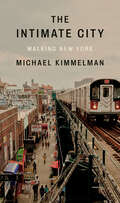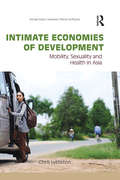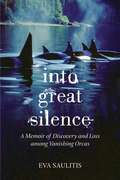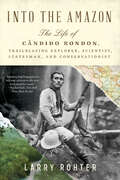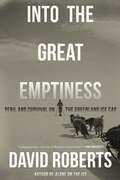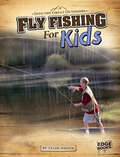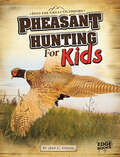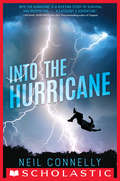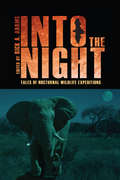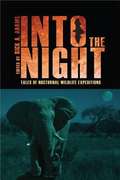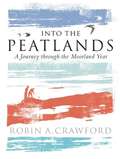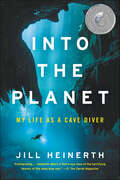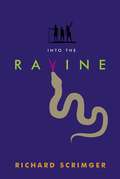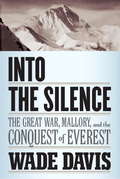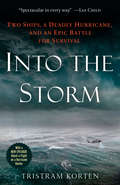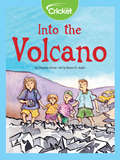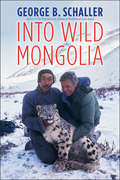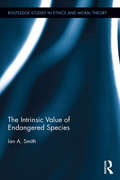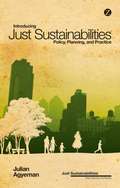- Table View
- List View
The Intimate City: Walking New York
by Michael KimmelmanFrom the New York Times architecture critic, his celebrated walking tours of New York City, now expanded, covering four of the five boroughs and some 540 million years of history, accompanied by some of the people who know it bestAs New York came to a halt with COVID, Michael Kimmelman composed an email to a group of architects, historians, writers, and friends, inviting them to take a walk. Wherever they liked, he wrote—preferably someplace meaningful to them, someplace that illuminated the city and what they loved about it. At first, the goal was distraction. At a scary moment when everything seemed uncertain, walking around New York served as a reminder of all the ways the city was still a rock, joy, and inspiration. What began with a lighthearted trip to explore Broadway&’s shuttered theater district and a stroll along Museum Mile when the museums were closed soon took on a much larger meaning and ambition. These intimate, funny, richly detailed conversations between Kimmelman and his companions became anchors for millions of Times readers during the pandemic. The walks unpacked the essence of urban life and its social fabric—the history, plans, laws, feats of structural engineering, architectural highlights, and everyday realities that make up a place Kimmelman calls &“humanity&’s greatest achievement.&” Filled with stunning photographs documenting the city during the era of COVID, The Intimate City is the ultimate insider&’s guide. The book includes new walks through LGBTQ Greenwich Village, through Forest Hills, Queens, and Mott Haven, in the Bronx. All the walks can be walked, or just be read for pleasure, by know-it-all New Yorkers or anyone else. They take readers back to an age when Times Square was still a beaver pond and Yankee Stadium a salt marsh; across the Brooklyn Bridge, for green tea ice cream in Chinatown, for momos and samosas in Jackson Heights, to explore historic Black churches in Harlem and midcentury Mad Men skyscrapers on Park Avenue. A kaleidoscopic portrait of an enduring metropolis, The Intimate City reveals why New York, despite COVID and a long history of other calamities, continues to inspire and to mean so much to those who call it home and to countless others.
Intimate Economies of Development: Mobility, Sexuality and Health in Asia (Routledge Studies in Development, Mobilities and Migration)
by Chris LyttletonAspirations, desires, opportunism and exploitation are seldom considered as fundamental elements of donor-driven development as it impacts on the lives of people in poor countries. Yet, alongside structural interventions, emotional or affective engagements are central to processes of social change and the making of selves for those caught up in development’s slipstream. Intimate Economies of Development lays bare the ways that culture, sexuality and health are inevitably and inseparably linked to material economies within trajectories of modernization in the Greater Mekong Sub-region. As migration expands and opportunities proliferate throughout Asia, different cultural groups increasingly interact as a result of targeted interventions and globalising economic formations; but they do so with different capabilities and expectations. This book uniquely grounds its arguments in interlocking details of people's everyday lives and aspirations in developing Asia, while also engaging with changing social values and moral frameworks. Part and parcel of a widening landscape of mobility and contingent intimacy is the ever-present threats of infectious disease, most prominently HIV/AIDS, and human trafficking. Thus, impact assessment and targeted interventions aim to address negative consequences that frequently accompany infrastructure development and market expansion. This path-breaking book, drawn on more than 20 years of ethnographic research in the Mekong region, shows how current models of mitigation cannot adequately cope with health risks generated by wide-ranging entrepreneurialism and enduring structural violence as dreams of ‘the good life’ are relentlessly enmeshed in strategies of livelihood improvement.
Into Great Silence: A Memoir of Discovery and Loss among Vanishing Orcas
by Eva SaulitisScience entwines with matters of the human heart as a whale researcher chronicles the lives of an endangered family of orcas Ever since Eva Saulitis began her whale research in Alaska in the 1980s, she has been drawn deeply into the lives of a single extended family of endangered orcas struggling to survive in Prince William Sound. Over the course of a decades-long career spent observing and studying these whales, and eventually coming to know them as individuals, she has, sadly, witnessed the devastation wrought by the Exxon Valdez oil spill of 1989--after which not a single calf has been born to the group. With the intellectual rigor of a scientist and the heart of a poet, Saulitis gives voice to these vital yet vanishing survivors and the place they are so loyal to. Both an elegy for one orca family and a celebration of the entire species, Into Great Silence is a moving portrait of the interconnectedness of humans with animals and place--and of the responsibility we have to protect them.From the Hardcover edition.
Into the Amazon: An Incredible Story of Survival in the Jungle
by John HarrisonIn 1950, a young French explorer entered deep jungle in Brazil and was never seen again. Inspired by that explorer's diary, John and Heather Harrison paddled their canoe into some of the remotest parts of the Amazon. This is the incredible story of their struggle to keep their sanity and marriage intact in one of the most hostile places on earth.
Into the Amazon: The Life Of Candido Rondon, Trailblazing Explorer, Scientist, Statesman, And Conservationist
by Larry Rohter“Rohter’s crisp biography is a welcome addition to the new, more inclusive canon.” —Rachel Slade, New York Times Book Review A thrilling biography of the Indigenous Brazilian explorer, scientist, stateseman, and conservationist who guided Theodore Roosevelt on his journey down the River of Doubt. Cândido Rondon is by any measure the greatest tropical explorer in history. Between 1890 and 1930, he navigated scores of previously unmapped rivers, traversed untrodden mountain ranges, and hacked his way through jungles so inhospitable that even native peoples had avoided them—and led Theodore Roosevelt and his son, Kermit, on their celebrated “River of Doubt” journey in 1913–14. Upon leaving the Brazilian Army in 1930 with the rank of a two-star general, Rondon, himself of indigenous descent, devoted the remainder of his life to not only writing about the region’s flora and fauna, but also advocating for the peoples who inhabited the rainforest and lobbying for the creation of a system of national parks. Despite his many achievements—which include laying down a 1,200-mile telegraph line through the heart of the Amazon and three nominations for the Nobel Peace Prize—Rondon has never received his due. Originally published in Brazil, Into the Amazon is the first comprehensive biography of his life and remarkable career.
Into the Badlands (Fountas & Pinnell Classroom, Guided Reading Grade 6)
by Mary ReidNIMAC-sourced textbook
Into the Clear Blue Sky: The Path to Restoring Our Atmosphere
by Rob JacksonFrom one of the world&’s leading climate scientists, a heart- and mind-changing book that offers a hopeful and attainable vision for restoring the atmosphere and ending the climate crisis.Climate change is here. From the millions displaced by the floods in Pakistan to Californian and Canadian towns incinerated by wildfires, we are experiencing the anguish that climate change causes. Fossil fuels are making the planet unlivable, and they are deadly. We know that we must cut emissions if we are going to limit the catastrophes, but is that enough? In Into the Clear Blue Sky, climate scientist and chair of the Global Carbon Project Rob Jackson explains that we need to redefine our goals. As he argues here, we shouldn&’t only be trying to stabilize the Earth&’s temperature at some arbitrary value. Instead, we can restore the atmosphere itself in a lifetime—and this should be our moral duty. Restoring the atmosphere means reducing the amount of greenhouse gases in the air to pre-industrial levels—starting with super-potent methane—to heal the harm we have done. Emissions must be cut, first and foremost. But to safeguard a livable planet for future generations, we must repair the damage we have caused. Jackson introduces us to the brilliant leaders and innovators behind some of the boldest and game-changing climate solutions under development. When it comes to greenhouse gas mitigation, our choices matter, because it is easier to stop emissions from happening than to remove greenhouse gases from the air later. But while mitigation is crucial, no number of solar panels, electric cars, and veggie burgers alone will be enough to halt climate change. Decades of inaction have convinced Jackson that we need to remove greenhouse gases from the air using everything from nature to cutting-edge technologies. Into the Clear Blue Sky is a heart- and mind-changing book. Guided by one of the leading scientists in this fight and a deeply gifted storyteller, we learn why we should all feel hopeful. One way or another, we will restore the planet together. The question is how, and how long will it take?
Into the Great Emptiness: Peril And Survival On The Greenland Ice Cap
by David RobertsA Library Journal Best Book of 2022 in Science and Technology “A gripping saga—and one of Roberts’s finest books.” —Jon Krakauer The riveting story of one of the greatest but least-known sagas in the history of exploration. By 1930, no place in the world was less well explored than Greenland. The native Inuit had occupied the relatively accessible west coast for centuries. The east coast, however, was another story. In August 1930, Henry George Watkins (nicknamed “Gino”), a twenty-three-year-old British explorer, led thirteen scientists and explorers on an ambitious expedition to the east coast of Greenland and into its vast and forbidding interior to set up a permanent meteorological base on the icecap, 8,200 feet above sea level. The Ice Cap Station was to be the anchor of a transpolar route of air travel from Europe to North America. The weather on the ice cap was appalling. Fierce storms. Temperatures plunging lower than –50° Fahrenheit in the winter. Watkins’s scheme called for rotating teams of two men each to monitor the station for two months at a time. No one had ever tried to winter over in that hostile landscape, let alone manage a weather station through twelve continuous months. Watkins was younger than anyone under his command. But he had several daring trips to the Arctic under his belt and no one doubted his judgement. The first crisis came in the fall when a snowstorm stranded a resupply mission halfway to the top for many weeks. When they arrived at the ice cap, there were not enough provisions and fuel for another two-man shift, so the station would have to be abandoned. Then team member August Courtauld made an astonishing offer. To enable the mission to go forward, he would monitor the station solo through the winter. When a team went up in March to relieve Courtauld, after weeks of brutal effort to make the 130-mile journey, they could find no trace of him or the station. By the end of March, Courtauld’s situation was desperate. He was buried under an immovable load of frozen snow and was disastrously short on supplies. On April 21, four months after Courtauld began his solitary vigil, Gino Watkins set out inland with two companions to find and rescue him. David Roberts, “veteran mountain climber and chronicler of adventures” (Washington Post), draws on firsthand accounts and archival materials to tell the story of this daring expedition and of the epic survival ordeal that ensued.
Into the Hurricane
by Neil ConnellyEli and Maxine fight to escape both the hurricane sweeping Shackles Island and the phantoms haunting them in this richly written survival story.TWO PEOPLE WITH LOSSESEli and Max both have good reasons to go to the lighthouse on Shackles Island. For Max, it's an old vacation spot, the rare location where she has only good memories -- so it's the right place to scatter her dad's ashes. For Eli, it's the highest point near his Louisiana home, with the clearest view of the rocks where his sister died -- so it's the right place to end his own life as well.A STORM WITHOUT LIMITSBut neither of them expected the other, nor the storm. Because Hurricane Celeste is roaring toward Shackles Island, and its power will break bridges, slash electric lines, and stir up deadly wildlife -- some of it human. When the ruthless Odenkirk family steals Max's Jeep with her most precious possession inside, she and Eli begin a desperate quest to get it back and get off the island ... until they realize they must go into the hurricane.
Into the Night: Tales of Nocturnal Wildlife Expeditions
by Rick AdamsThis entertaining collection of essays from professional scientists and naturalists provides an enlightening look at the lives of field biologists with a passion for the hidden world of nocturnal wildlife. Into the Night explores the harrowing, fascinating, amusing, and largely unheard personal experiences of scientists willing to forsake the safety of daylight to document the natural history of these uniquely adapted animals. Contributors tell of confronting North American bears, cougars, and rattlesnakes; suffering red ctenid spider bites in the tropical rain forest; swimming through layers of feeding-frenzied hammerhead sharks in the Galapagos; evading the wrath of African bull elephants in South Africa; and delighting in the curious and gentle nature of foxes and unconditional acceptance by a family of owls. They describe “fire in the sky” across a treeless tundra, a sea ablaze with bioluminescent algae, nighttime earthquakes on the Pacific Rim, and hurricanes and erupting volcanoes on a Caribbean island. Into the Night reveals rare and unexpected insights into nocturnal field research, illuminating experiences, discoveries, and challenges faced by intrepid biologists studying nature’s nightly marvels across the globe. This volume will be of interest to scientists and general readers alike.
Into the Night
by Rick A. AdamsThis entertaining collection of essays from professional scientists and naturalists provides an enlightening look at the lives of field biologists with a passion for the hidden world of nocturnal wildlife. Into the Night explores the harrowing, fascinating, amusing, and largely unheard personal experiences of scientists willing to forsake the safety of daylight to document the natural history of these uniquely adapted animals.Contributors tell of confronting North American bears, cougars, and rattlesnakes; suffering red ctenid spider bites in the tropical rain forest; swimming through layers of feeding-frenzied hammerhead sharks in the Galapagos; evading the wrath of African bull elephants in South Africa; and delighting in the curious and gentle nature of foxes and unconditional acceptance by a family of owls. They describe "fire in the sky" across a treeless tundra, a sea ablaze with bioluminescent algae, nighttime earthquakes on the Pacific Rim, and hurricanes and erupting volcanoes on a Caribbean island. Into the Night reveals rare and unexpected insights into nocturnal field research, illuminating experiences, discoveries, and challenges faced by intrepid biologists studying nature's nightly marvels across the globe. This volume will be of interest to scientists and general readers alike.
Into the Outdoors
by Susan GalIn Susan Gal's delightful young-concept book, a family travels up a mountain, over a bridge, and under a canopy of trees to reach their campsite in the great outdoors. A forest hike offers more opportunities to showcase words that describe spacial relationships and show young readers where they are in the world. Beside a lake! Next to a waterfall! On top of a mountain! Then after the sun slips behind the hills, they'll snuggle alongside each other and dream sweet dreams inside their tent among the trees.Gal's pictures capture all the beauty of the natural world. And she's included a humorous cast of animal characters on a parallel journey of their own, so the art is full of funny things to spot.This is a gem of a story for parents and teachers to share with their happy campers.From the Hardcover edition.
Into the Peatlands: A Journey through the Moorland Year
by Robin CrawfordA portrait of these Scottish wetlands: &“Fascinating…makes you yearn for a sip of golden whisky whose barley malt has been smoked over a rich, peaty fire.&” —Daily Mail The peatlands of Scotland&’s Outer Hebrides are half land, half water. Their surface is a glorious tweed woven from tiny, living sphagnums rich in wildlife, but underneath are layer upon layer of dead mosses transforming into the peat. One can, with care, walk out onto them, but stop and you begin to sink into them. For time immemorial the peatlands have been places—for humans at least—of seasonal habitation but not of constant residence. In this book, Robin A. Crawford explores the peatlands over the course of the year, explaining how they have come to be and examining how peat has been used from the Bronze Age onwards. In describing the seasonal processes of cutting, drying, stacking, storing, and burning, he reveals one of the key rhythms of island life, but his study goes well beyond this to include many other aspects, including the wildlife and folklore associated with these lonely, watery places. Widening his gaze to other peatlands in the country, he also reflects on the historical and cultural importance that peat has played, and continues to play—it is still used for fuel in many rural areas and plays an essential role in whisky-making—in the story of Scotland.
Into the Planet: My Life As A Cave Diver
by Jill HeinerthTaking you to places no one has ever gone before, and blending memoir, adventure, and science, Into the Planet is a riveting account of one of the most dangerous yet exhilarating pursuits in the world: diving to the centre of the earth."If I die, it will be in the most glorious place that nobody has ever seen."As one of the most celebrated cave divers in the world, Jill Heinerth has seen the planet in a way almost no one has. In a workday, she might swim below your home, through conduits in volcanoes or cracks in the world's largest iceberg. She's an explorer, a scientist's eyes and hands underwater—discovering new species and examining our finite freshwater reserves—and a filmmaker documenting the wonders of underwater life. Often the lone woman in a male-dominated domain, she tests the limits of human endurance at every tight turn, risking her life with each mission. To not only survive in this world but excel, Jill has had to learn how to master self-doubt like no other.With gripping storytelling that radiates intimacy, Into the Planet will transport you deep into the most exquisite, untouched corners of the earth, where fear must be reconciled and the innermost parts of the human condition are revealed.
Into the Planet: My Life as a Cave Diver
by Jill HeinerthThe renowned cave diver takes readers on “a thrill ride into unfamiliar worlds”—exploring the hidden depths of our oceans and sunken caves (Publishers Weekly).More people have died exploring underwater caves than climbing Mount Everest, and we know more about deep space than we do about the depths of our oceans. In this thrilling firsthand account, Jill Heinerth blends science, adventure, and memoir to bring readers face-to-face with the terror and beauty of earth’s final frontier—and the extremes of human capability.One of the world’s foremost cave divers, Heinerth’s achievements include leading a team that discovered the ancient watery remains of Mayan civilizations and becoming the first person in history to dive deep into an Antarctic iceberg. In Into the Planet, she vividly recounts everything from discovering new species and examining our finite freshwater reserves to the prejudices women face when pursuing careers underwater.
Into the Ravine
by Richard ScrimgerIn the tar-melting heat of a suburban summer, everybody Jules, athletic and handsome Chris, and oddball Corey have lived side by side for most of their lives. Behind their backyards is a ravine through which flows a modest river.
Into the Sea
by Brenda Z. Guiberson Alix Berenzy<p>Brenda Z. Guiberson’s Into the Sea follows the fragile life cycle of an endangered sea turtle in a children’s picture book story gorgeously illustrated by Alix Berenzy. <p>From the moment it hatches from its shell through its journey across an ocean filled with wonders and dangers to its return to the beach where it was born to lay its own eggs, a female sea turtle’s life is one of survival.</p>
Into the Silence: The Great War, Mallory and the Conquest of Everest
by Wade DavisOn June 6, 1924, two men set out from a camp perched at 23,000 feet on an ice ledge just below the lip of Mount Everest's North Col. George Mallory, thirty-seven, was Britain's finest climber. Sandy Irvine was a young Oxford scholar of twenty-two with little previous mountaineering experience. Neither of them returned. In this magisterial work of history and adventure, based on more than a decade of prodigious research in British, Canadian, and European archives, and months in the field in Nepal and Tibet, Wade Davis vividly re-creates British climbers' epic attempts to scale Mount Everest in the early 1920s. With new access to letters and diaries, Davis recounts the heroic efforts of George Mallory and his fellow climbers to conquer the mountain in the face of treacherous terrain and furious weather. Into the Silence sets their remarkable achievements in sweeping historical context: Davis shows how the exploration originated in nineteenth-century imperial ambitions, and he takes us far beyond the Himalayas to the trenches of World War I, where Mallory and his generation found themselves and their world utterly shattered. In the wake of the war that destroyed all notions of honor and decency, the Everest expeditions, led by these scions of Britain's elite, emerged as a symbol of national redemption and hope. Beautifully written and rich with detail, Into the Silence is a classic account of exploration and endurance, and a timeless portrait of an extraordinary generation of adventurers, soldiers, and mountaineers the likes of which we will never see again.From the Hardcover edition.
Into the Storm: Two Ships, a Deadly Hurricane, and an Epic Battle for Survival
by Tristram Korten“An intense, immersive deep dive into a wild, dangerous, and unknown world, written with the pace and appeal of a great thriller. This is nonfiction at its very best.”—Lee ChildThe true story of two doomed ships and a daring search-and-rescue operation that shines a light on the elite Coast Guard swimmers trained for the most dangerous ocean missions In late September 2015, Hurricane Joaquin swept past the Bahamas and swallowed a pair of cargo vessels in its destructive path: El Faro, a 790-foot American behemoth with a crew of thirty-three, and the Minouche, a 230-foot freighter with a dozen sailors aboard. From the parallel stories of these ships and their final journeys, Tristram Korten weaves a remarkable tale of two veteran sea captains from very different worlds, the harrowing ordeals of their desperate crews, and the Coast Guard’s extraordinary battle against a storm that defied prediction. When the Coast Guard received word from Captain Renelo Gelera that the Minouche was taking on water on the night of October 1, the servicemen on duty helicoptered through Joaquin to the sinking ship. Rescue swimmer Ben Cournia dropped into the sea—in the middle of a raging tropical cyclone, in the dark—and churned through the monstrous swells, loading survivors into a rescue basket dangling from the helicopter as its pilot struggled against the tempest. With pulsating narrative skill in the tradition of Sebastian Junger and Jon Krakauer, Korten recounts the heroic efforts by Cournia and his fellow guardsmen to haul the Minouche’s crew to safety. Tragically, things would not go as well for Captain Michael Davidson and El Faro. Despite exhaustive searching by her would-be rescuers, the loss of the vessel became the largest U.S. maritime disaster in decades. As Korten narrates the ships’ fates, with insights drawn from insider access to crew members, Coast Guard teams, and their families, he delivers a moving and propulsive story of men in peril, the international brotherhood of mariners, and the breathtaking power of nature.Advance praise for Into the Storm “An incredible story and first-rate adventure . . . Tristram Korten delivers us into a thrilling and dangerous world, strapping us in beside everyday heroes who confront forces of nature even Hollywood can’t re-create.”—Robert Kurson, New York Times bestselling author of Shadow Divers “A terrifying but also inspiring story of disaster and resilience on the high seas . . . riveting stuff.”—Josh Dean, author of The Taking of K-129
Into the Volcano
by Charnan SimonDid you know that Hawaii is still being built, even today? Heidi learns all about how Kilauea, the most active volcano in the world, erupts and spills more lava every day, making the island grow! She also gets to visit Mauna Loa, the biggest mountain in the world. What do you think it might be like to visit?
Into Wild Mongolia
by George B. SchallerExplore the wonders of wild Mongolia through the eyes of a distinguished field biologist Mongolia became a satellite of the Soviet Union in the mid-1920s, and for nearly seven decades effectively closed its doors to the outside world. Biologist George Schaller initially visited the country in 1989, and was one of the first Western scientists allowed to study and assess the conservation status of Mongolia&’s many unique, native wildlife species. Schaller made a number of trips from 1989 to 2018 in collaboration with Mongolian and American scientists, witnessing Mongolia&’s recovery and transition to a market economy after the collapse of the Soviet Union. This informative and fascinating new book provides a firsthand account of Schaller&’s time in this little-known and remote country, where he studied and helped develop conservation initiatives for the snow leopard, Gobi bear, wild camel, and Mongolian gazelle, among other species. Featuring magnificent photographs from his travels, the book offers a critical, at times inspiring contribution for those who treasure wildlife, as well as a fresh perspective on the natural beauty of the region, which encompasses steppes, mountains, and the Gobi Desert.
The Intrinsic Value of Endangered Species (Routledge Studies in Ethics and Moral Theory)
by Ian A. SmithWhy save endangered species without clear aesthetic, economic, or ecosystemic value? This book takes on this challenging question through an account of the intrinsic goods of species. Ian A. Smith argues that a species’ intrinsic value stems from its ability to flourish—its organisms continuing to reproduce successfully and it avoiding extinction—which helps to demonstrate a further claim, that humans ought to preserve species that we have endangered. He shows our need to exercise humility in our relations with endangered species through the preservation of their intrinsic goods, which in turn rectifies our degradation of their importance. Unique in its appeal to virtue ethics and to species concepts, The Intrinsic Value of Endangered Species is an important resource for scholars working in environmental ethics and the philosophy of biology.
Introducing Just Sustainabilities: Policy, Planning, and Practice
by Julian AgyemanThis unique and insightful text offers an exploration of the origins and subsequent development of the concept of just sustainability.
